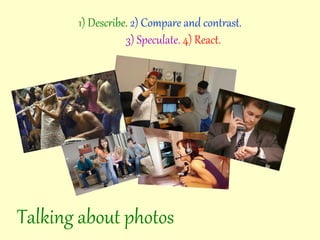Compareandcontrastphotos 110928092212-phpapp01
- 1. 1) Describe. 2) Compare and contrast. 3) Speculate. 4) React. Talking about photos
- 2. 1) Describe the photo. ? Describe what you can see and what is happening in the photos. ? Say where it¡¯s happening; ie on the right / left, at the bottom / top, in the middle, behind, in front... ? Use Present Continuous. What are they doing? ? What clothes are they wearing ? What¡¯s the weather like? ? Are they inside or outside? ? Use adjectives. Do they look happy, sad, angry, bored, tired..? ? How does the photo make you feel? ? Would you like to be there? Why / Why not? 1) Describe. 2) Compare and contrast. 3) Speculate. 4) React.
- 3. Comparing and contrasting photos What vocabulary do we use? Similarities; all, ... ... and Differences; ... but ... 1) Describe. 2) Compare and contrast. 3) Speculate. 4) React.
- 4. Comparing and contrasting photos What vocabulary do we use? Similarities; all, most, some, both... ... and, also, as well, too Differences; ... but / however / whereas / while / on the other hand... Although... ¡°In both photos the woman is blond. In the photo on the left she is wearing a white shirt whereas in the photo on the right she is wearing a black coat¡±. 1) Describe. 2) Compare and contrast. 3) Speculate. 4) React.
- 5. Speculate about the situation What language do we use? 1) Describe. 2) Compare and contrast. 3) Speculate. 4) React.
- 6. Speculate about the situation What language do we use? Use may / might / could / must / can¡¯t be... He seems to / appears to be... Make some sentences 1) Describe. 2) Compare and contrast. 3) Speculate. 4) React.
- 7. Speculate about the situation What language do we use? Use may / might / could / must / can¡¯t be... He seems to / appears to be... Make some sentences ¡°They seem to be very happy. Their team must be winning¡±. 1) Describe. 2) Compare and contrast. 3) Speculate. 4) React.
- 8. Give your reaction What language can we use? 1) Describe. 2) Compare and contrast. 3) Speculate. 4) React.
- 9. Give your reaction What language can we use? I¡¯d love / hate to do that! It looks great / dangerous / awful! It makes me want to try / go there... It wouldn¡¯t suit me. 1) Describe. 2) Compare and contrast. 3) Speculate. 4) React.
- 10. 1) Describe. 2) Compare and contrast. 3) Speculate. 4) React. Now talk about some of the following photos.
- 11. 1) Describe. 2) Compare and contrast. 3) Speculate. 4) React.
- 12. 1) Describe. 2) Compare and contrast. 3) Speculate. 4) React.
- 13. 1) Describe. 2) Compare and contrast. 3) Speculate. 4) React.
- 14. 1) Describe. 2) Compare and contrast. 3) Speculate. 4) React.
- 15. 1) Describe. 2) Compare and contrast. 3) Speculate. 4) React.
- 16. 1) Describe. 2) Compare and contrast. 3) Speculate. 4) React.
- 17. 1) Describe. 2) Compare and contrast. 3) Speculate. 4) React.
- 18. 1) Describe. 2) Compare and contrast. 3) Speculate. 4) React.
- 19. 1) Describe. 2) Compare and contrast. 3) Speculate. 4) React.
- 20. 1) Describe. 2) Compare and contrast. 3) Speculate. 4) React.
- 21. 1) Describe. 2) Compare and contrast. 3) Speculate. 4) React.
- 22. 1) Describe. 2) Compare and contrast. 3) Speculate. 4) React.
- 23. 1) Describe. 2) Compare and contrast. 3) Speculate. 4) React.
- 24. 1) Describe. 2) Compare and contrast. 3) Speculate. 4) React.
- 25. 1) Describe. 2) Compare and contrast. 3) Speculate. 4) React.
- 26. 1) Describe. 2) Compare and contrast. 3) Speculate. 4) React.
- 27. 1) Describe. 2) Compare and contrast. 3) Speculate. 4) React.
- 28. 1) Describe the photo. ? Describe what you can see and what is happening in the photos. ? Say where it¡¯s happening; ie on the right / left, at the bottom / top, in the middle, behind, in front... ? Use Present Continuous. What are they doing? ? What clothes are they wearing ? What¡¯s the weather like? ? Are they inside or outside? ? Use adjectives. Do they look happy, sad, angry, bored, tired..? ? How does the photo make you feel? ? Would you like to be there? Why / Why not? 1) Describe. 2) Compare and contrast. 3) Speculate. 4) React. 2) Comparing and contrasting photos Similarities; all, most, some, both... ... also, as well, too. Differences; ... but / however / whereas / while / on the other hand... Although... 3) Speculate about the situation Use may / might / could / must / can¡¯t be... He seems to / appears to be... 4) Give your reaction I¡¯d love / hate to do that! It looks great / dangerous / awful! It makes me want to try / go there... It wouldn¡¯t suit me.




























